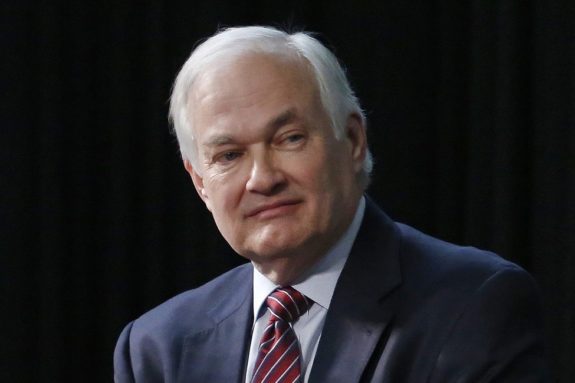The Collective Bargaining Agreement (CBA) between the NHL and the National Hockey League Players’ Association is an incredibly detailed, occasionally dense, 500-plus page piece of finely crafted legalese. The current CBA went into effect in September 2012 and remains in effect until at least September 2022. (If you’re quarantined, extremely bored, into legal jargon, or all of the above, the full text of the current Collective Bargaining Agreement can be downloaded here.)
It was hammered out under the leadership of NHL Executive Director Gary Bettman (representing the league and the club owners) and NHLPA Executive Director Donald Fehr (representing the union and the players).

It covers just about every aspect of a hockey player’s (and club’s) professional obligations, responsibilities, and compensation. Among the most commonly known (if not truly understood) aspects of the agreement are the salary cap for each team, trade and draft restrictions, free agency, and revenue sharing. However, if you look through the document, you’ll also find pages of information on such subjects as which players get single rooms on the road, and “Spousal Airfare” (they travel economy class).
Related: 8 Ways To (Legally) Circumvent The NHL Salary Cap
Right now, however, as we await the return of professional hockey, a couple of clauses might have an impact on which teams qualify for the Stanley Cup Playoffs (assuming that play resumes in 2020). Let’s start with the little one.
CBA Article 16.3 Length of Season, Balance and Consistency
16.3 (b) Each Club will play at least one (1) NHL Game during the first three (3) days of the Regular Season and at least one (1) NHL Game during the last three (3) days of the Regular Season.
That Article says “last three (3) days of the Regular Season.” Not “the last three (3) days that the schedulers put together for an 82-game Regular Season.” As it happened, the final day of play prior to The Pause for the coronavirus pandemic was Wednesday, March 11. So, in accordance with the CBA, the last three days of the Regular Season would have been March 9, 10, and 11.

As fate would have it, not all 31 NHL teams played during those three days. The Columbus Blue Jackets, Minnesota Wild, and Calgary Flames all had days off March 9–11. However, all three teams did play on March 8, and between March 8 and 10, all 31 teams played at least one game. So, if one were to nit-pick the CBA and attempt to invoke Article 16.3 (b), “the last three (3) days of the Regular Season” would need to be March 8–10, not March 9–11.
Before we look at how that change impacts playoff positioning based on “percentage of possible points” (or “points percentage”), let me remind you that an alternative conclusion for the NHL’s 2019-20 regular season would be to end each team’s regular season after their 68th game. Since each team would have actually played in their 68th game, the terms of Article 16.3 (b) would be fulfilled.
Related: 1st Round Playoff Predictions After a 68-Game Regular Season
Points percentage works like this: Multiply the number of games played by a team by 2. That gives you the maximum number of points that team could have earned — 2 points for a win, win every game, and that’s how many points the team could theoretically earn. Now, take the number of games the team actually won (in regulation time, overtime, or shootout), multiply by 2, add 1 point for each game lost in overtime or a shootout, and you get the team’s points actually earned during the season. Divide the points earned by the maximum points possible, and you have that team’s points percentage.
The Boston Bruins, for example, played 70 games. If they had won all 70, their points (the maximum) would be 140. With an actual record of 44 wins, 14 losses, and 12 OT/SO losses, the points are (44×2) + (12×1) = 100 points earned. 100 divided by 140 = .71428571 or through rounding .714. Boston had the best record in the league at the time of The Pause, so that’s the highest points percentage for the 2019-20 season… right now.

On the other end of the spectrum you find the Detroit Red Wings, whose record of 17 wins, 49 losses, and 5 OT/SO losses was worst in the league. 71 games played for a max of 142 points, 39 points actually earned, and a points percentage of .275.
CBA Article 16.3 (b) and the NHL 2019-20 Season
So what would happen if we changed the final three games of the Regular Season from March 9–11 to March 8–10? Interestingly, the teams that played on March 11 would benefit from losing rather than winning when it comes to points percentage. Reducing the maximum points by 2 (1 fewer game played) is mathematically more significant than subtracting 2 points for a win but also 2 points for maximum points.
Weird, huh? Cutting off games played on March 11 rewards the teams that lost on that day, but punishes the teams that won. PTS = points earned, MAX = maximum possible points (games played x 2). Keeping the same PTS (a loss on March 11) but dividing by the lower MAX-2 (1 fewer game played) produces a higher points percentage than subtracting a win on March 11 (PTS-2) divided by the lower MAX-2.
And, yes, that other thing that could have happened actually did: There was indeed an overtime loss (the New York Rangers to the Colorado Avalanche). Not surprisingly, losing 1 point earned (rather than 2 points for a win or zero points for a loss) and dividing by MAX-2 puts points percentage smack dab in the middle of a win or a loss on March 11 for the Rangers.

Here are the actual results of games played on March 11:
Winners (PTS-2): Chicago Blackhawks, Winnipeg Jets, St. Louis Blues, Colorado, and the Los Angeles Kings.
Losers (PTS unchanged): San Jose Sharks, Edmonton Oilers, Anaheim Ducks, and the Ottawa Senators.
OT Loss (PTS-1): Rangers.
As it turns out, there are no significant results in terms of playoff positioning or draft lottery if the last three (3) days of the Regular Season are moved back from March 9–11 to March 8–10.
However, St. Louis and Colorado both won on March 11. If St. Louis had won and Colorado has lost that overtime game against the Rangers, the Avalanche would have jumped ahead of the Blues and earned a first-round matchup with the second wild card team rather than the Central Division’s third-place team. But that didn’t happen and we can safely ignore CBA Article 16.3 (b). This year.
CBA Article 16.2 Playoff Games
Here you have the full wording of the entire Article:
16.2 The NHLPA has consented to granting the League, either in the 2005-06 NHL Season, or, alternatively, in the 2006-07 NHL Season, the option to institute in any League Year a “Playoff Qualification Round” preliminary to the Playoffs, which will consist of one (1) round involving four (4) Clubs in each Conference, with each series in the round having a maximum of three (3) games, with the winner of each series advancing to the Playoffs. If the League institutes a Playoff Qualification Round in either 2005-06 or 2006-07, the parties agree to thereafter jointly evaluate and discuss such experience. If the League desires to implement a Playoff Qualification Round with respect to future NHL Season(s), it may only do so with the consent of the NHLPA, which shall not be unreasonably withheld. The Playoffs will consist of four (4) rounds, with each series in each round having a maximum of seven (7) games.
Boiling down CBA Article 16.2
Seasons 2005-06 and 2006-07 are history and we know the NHL and NHLPA didn’t agree then to a Playoff Qualification Round. (You may also hear this referred to as a “play-in round.”) But note the wording “If the League desires to implement a Playoff Qualification Round with respect to future NHL Season(s)…”
The 2019-20 season definitely falls into the category of “future NHL Season(s).” So, if the league and the union agree, an initial best-of-three (or even a one-game) Playoff Qualification Round can be added prior to the start of the actual Stanley Cup Playoffs. Four clubs in each conference would participate in the Playoff Qualification Round, resulting in two winners in each conference advancing to the Stanley Cup Playoffs.

Remember that last clause in Article 16.2: “The Playoffs will consist of four (4) rounds, with each series in each round having a maximum of seven (7) games.” That does not exactly say “each round must be a best-of-seven (7) series,” does it? It eliminates a best-of-9 series, but not a best-of-5 or even a best-of-3 series.
Related: The NHL Point System is Flawed
We can logically assume that the purpose of such a Playoff Qualification Round, “having a maximum of three (3) games,” would be to determine the wild card teams. We can also assume (although it is not stated in the CBA) that in each conference, the two current wild card holders and the teams with the two next-best records would be involved.
Again, not specified in the CBA, we can assume that in each conference the best record of the four would play the worst record, and the two remaining teams would play each other. The winners of each series would advance to the 2020 Stanley Cup Playoffs (in whatever form they may hold) as the wild cards.
Related: 2020 NHL Playoff Odds – Is Your Team In or Out?
Before determining rankings for the Playoff Qualification Round, we need to look at tie-breaking in the CBA. You’ll find little more than carry-over language in this CBA, except in Article 13.19, which determines order of standing when more than one team claims a player off waivers during the season.
With waivers, the worst team wins, so we’ll flip it around to find the team with the better standing.
- The team with the higher percentage of possible points.
- The team with the highest winning percentage of games decided in regulation or overtime. (Does not include shootouts.) This was a change to tie-breaking added in 2010.
- Points won in games against each other (minus “odd games”).
- Goal differential.
Playoff Qualification Round in the Eastern Conference
Alright, we’ve got our tie-breakers, but what system should we use? Current standings? Points percentage? A 68-game regular season? And how will the results differ? In fact, some folks think the current playoff format is broken and the whole idea of divisions should be ignored come playoff time.
Current Standings
Using the current standings, the Eastern Conference playoff picture looks like this: For the Metropolitan Division, the Washington Capitals, Philadelphia Flyers, and Pittsburgh Penguins are in. For the Atlantic, Boston, the Tampa Bay Lightning, and the Toronto Maple Leafs are in.

The two current wild card teams are the Carolina Hurricanes and the Blue Jackets, both with 81 points. The next two teams – the Playoff Qualification Round teams – would be the New Yorkers, both the Islanders (80 points) and Rangers (79 points)
Points Percentage
Using the points percentage (with or without CBA Article 16.3 (b)), the Eastern Conference playoff picture looks like this: For the Metropolitan Division, the Capitals, Flyers, and Penguins are in. For the Atlantic, the Bruins, Lightning, and Maple Leafs are in. The two current wild card teams are the Hurricanes (.596) and the Islanders (.588). The next two teams – the Playoff Qualification Round teams – would be the Blue Jackets (.579) and the Florida Panthers (.565, a scant .001 ahead of the Rangers).
68-game Season
When truncating the season to the first 68 games played by each team, the Eastern Conference looks a bit different. For the Metropolitan Division, the Capitals, Flyers, and Penguins are in. For the Atlantic, Boston, the Lightning, and the Maple Leafs are in. The two current wild card teams are the Hurricanes and the Islanders. The next two teams – the Playoff Qualification Round teams – are the Blue Jackets and the Rangers (in a tie-breaker over Florida).
Playoff Qualification Round in the Western Conference
In the Western Conference, we’ll again look at all three possible end-of-season scenarios.
Current Standings
By straight-up points as of The Pause on March 11, the top three teams in the Central Division are the St. Louis Blues, Colorado Avalanche, and Dallas Stars. In the Pacific Division, it’s the Vegas Golden Knights, the Edmonton Oilers, and the Flames.

The wild cards are the Winnipeg Jets and Nashville Predators (in the regulation wins tie-breaker over the Vancouver Canucks). Teams added for the Playoff Qualification Round are Vancouver and Minnesota.
Points Percentage
Using the “percentage of possible points” formula, the Central Division top trio remains the same: Blues, Avalanche, and Stars. The Pacific, however, starts with the Golden Knights and Oilers, but the third-place team flips from Calgary to Vancouver. The wild card teams are Nashville and the Flames, with the final two qualification round teams both from the Central Division — the Jets and Wild.
68-game Season
Limiting each team to its first 68 games, here’s how the Western Conference playoff picture shakes out. The top three in the Central Division become the Avalanche, ahead of the Blues in a tie-breaker, then the Stars. The Pacific leaders are the Golden Knights, Oilers, with the Flames in third. The wild cards are Vancouver and Nashville, with their Playoff Qualification Round opponents the Wild (vs. Nashville) and Winnipeg (vs. Vancouver).
Who Benefits from Implementing CBA Article 16.2?
Obviously, teams that would not otherwise be in the playoffs are the beneficiaries of a Playoff Qualification Round. Winnipeg and Columbus are teams that sit in wild card spots right now — using just the points earned in the standings. Adding the Playoff Qualification Round is the teams’ only chance to qualify under any equitable way to end the season, unless regular-season games resume in some limited format. The Wild and the Rangers (or, perhaps the Panthers) don’t get a sniff of the playoffs without the Playoff Qualification Round (or resumption of regular-season games).
There’s another group that would benefit from a Playoff Qualification Round to start the chase for Lord Stanley’s Cup: the fans. Who wouldn’t want to see an extra round of playoffs?